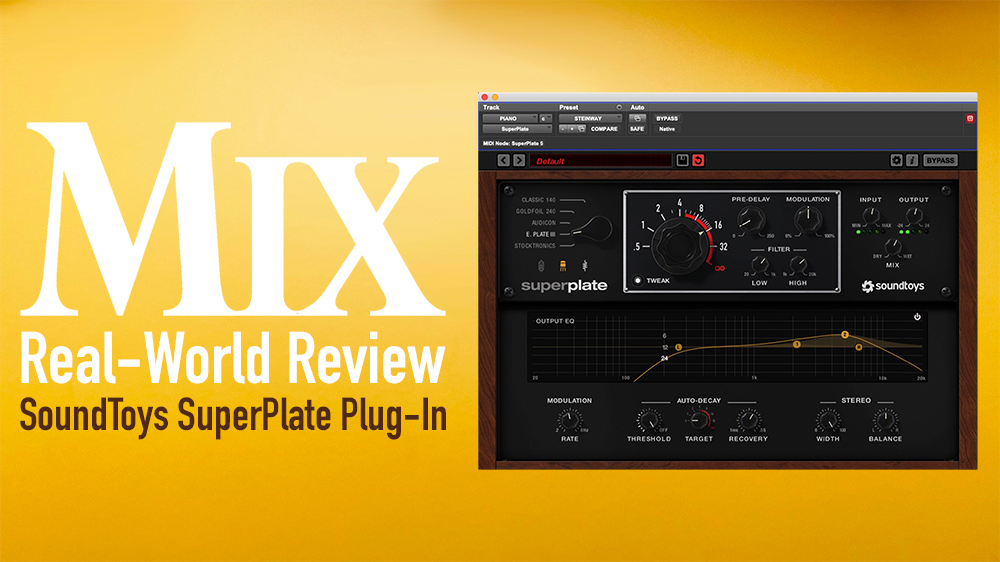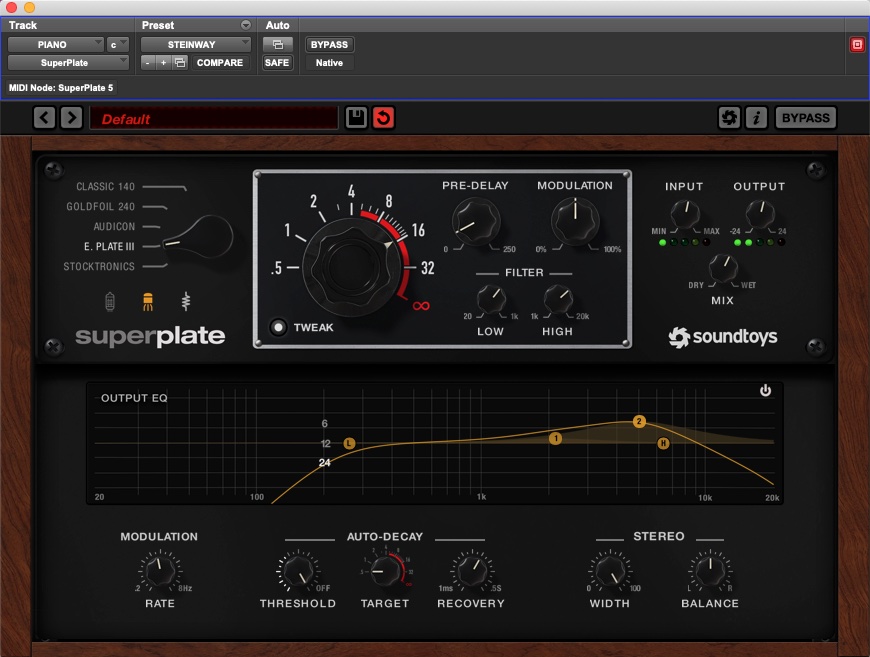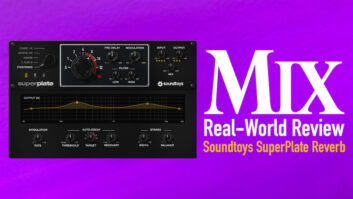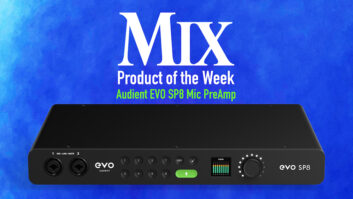
| MIX VERDICT: SOUNDTOYS SUPERPLATE |
| THE TAKEAWAY: “SuperPlate is more than worth the wait. It’s taking the plate reverb to the next level, and I use it as much as a sound design tool as a reverb.” |
| COMPANY: SoundToys • www.soundtoys.com PRICE: $149 PROS: • Five old-fashioned, tone-soaked plate reverbs. • Useful presets. • Unique Auto-Decade option. |
What’s better than an excellent, old-fashioned, tone-soaked plate reverb? Five of them! That’s especially true when they all come wrapped inside a single plugin.
Add in some preamp models, equalization, filters and ducking options, and that’s just what Soundtoys SuperPlate offers. Let’s explore some of the features that make this new release so useful.
The most prominent feature is the fact that this powerful plug offers the option of choosing from five meticulously modeled plate reverbs: EMT 140, EMT 240, Audicon, Stocktronics RX4000 and EcoPlate III. On top of that, you can select from three kinds of preamp color: Clean, Tube and Solid State. Add in some modern controls such as pre-delay, modulation, a full-feature EQ with Low and High Filters, a decay ducking feature, and, of course, infinite decay time, and…well, there are a lot of options to play with.
Let’s start with the preamps. Tube mode is based on the original EMT V54 preamp from the original EMT 140 plates. Solid State mode is from the EMT 162 preamp used in later versions of the EMT 140; it also features a built-in compressor. Clean mode has no preamp modeling, taking away any of the dynamics or harmonic distortion characteristics.
You get both a low-cut filter (20 Hz to 1kHz) with selectable slopes and a high-cut filter (20 kHz to 1 kHz), also with selectable slopes. Pre-delay ranges from 0 to 250 msi and modulation can be further tweaked with the Modulation rate in the Tweak Menu.

KNOBS AND CONTROLS
The Input knob controls the amount of signal sent to the preamp, and the Output knob controls the overall amplitude and volume of the effected signal post-reverb.
A Mix knob controls the wet/dry ratio and lets you place SuperPlate directly on a track if you so choose. The large Decay Time knob, which allows for the choice of either short or long (measurements of RT60 at 500 Hz) settings, is where most of the action takes place. By turning it fully clockwise, the unit will go into infinite decay.
The Tweak button opens a Tweak Menu, which offers Modulation Rate, Stereo Width and Balance (L/R), and 2-band parametric EQ, all post-reverb.
You simply click and hold one of the EQ selections, and it defaults to a wide bandwidth. To tighten the Q, simply hold down Control on a Mac and Alt on Windows. In the upper right of the EQ display, a small toggle switch allows you to turn off the EQ bands but leave the Low-and High-Cut filters on.
One of the more unique features in the Tweak menu is the Auto-Decay option. It gives you dynamic control over the decay time, depending on the amplitude of the input signal.
It’s helpful in lessening the buildup when using long reverb times. The Threshold knob sets where it will start to engage, Target defines how much reduction happens past the threshold, while the Recovery knob sets how fast or slow the decay returns to its normal setting, from 1 ms to 0.5 seconds.
PUTTING THE TOYS IN PLAY
I found that a great way to first learn the basic sound differences between the five models is to take a source like a cymbal swell or piano note, something that has a nice top frequency range, and quickly run it through each plate type. For example, after starting with the Classic 140 and switching to the Stocktronics, you can hear the clarity up top change. Then to the Goldfoil 240, where the low-mids become more pronounced.
The AudionSTET and E Plate III are the closest in character to each other, and then back to the Classic 140, which sounds great on almost anything—always.
From there, you can click through the preamp types, experiment with driving the input and lowering the output, then push the boundaries of the EQ, which I love to do. I love gobs of reverb on things like cymbals, pianos and strings, so I pushed the Decay Time knob above 16 and turned up the EQ bands to create a lush environment where sounds can swim in the sonic goodness.
By adding in some modulation, you can get pitch shifts that border on uncomfortable, which is just how I like it. This is especially true when you overdrive the tube setting, turning up the Input and adjusting the Output to accommodate the new levels. I also got some great results by automating both the EQ and modulation parameters to create sonic palettes that ebb and flow.
I would be remiss if I didn’t mention that there are some amazing presets in the Soundtoys Effect Rack, which can use up to 15 Soundtoys effects in one plug-in, including SuperPlate, if you have the licenses to do so.
NEXT-LEVEL REVERB
Long in the making, SuperPlate is more than worth the wait. It’s taking the plate reverb to the next level, and I use it as much as a sound design tool as a reverb. From short hits on guitars and snares to monster tails on pads and pianos, you’re left with something that you want to feature in every mix.
SIDEBAR: TURNING A PLATE INTO A PLUG-IN
To find out a little more about the excellent modeling of these classic reverbs, I ran a few questions by Chris Santoro, SoundToys’ Lead Engineer. He explains:
“As far as sourcing the plates and ‘why them,’ we simply tried to collect and model at least one of every major commercial plate reverb that has ever existed. Some of these plates were nearly unobtainable and took a while to track down, while for others we were actually able to find and invest in multiple units. Since all electromechanical gear is unique, it was useful to have multiple versions to listen to and see how much they varied. Having multiples also allowed us to experiment with tuning them by adjusting the tension to see how that changes the sound, without fear of breaking one. Not only did we have multiple sets of some of the plates, we also collected multiple sets of electronics (drivers and amplifiers) for the EMT140s to explore all the variations and mods that have existed throughout the years. In the end, we chose the units that we felt sounded the best and were representative of ‘that sound.’
“As far as turning them into software, we measured the plates and their associated electronics in various ways, and we developed some proprietary techniques to match the sound using a specially designed reverb algorithm. Convolution could have captured many of these plates decently, but using a sophisticated algorithm allowed us to extend the plates to do all the extra fun and ‘impossible’ stuff—like extended decay times and decay ducking—to make SuperPlate more than just a plate modeling reverb.
“Plate reverbs are an important part of recording history and culture, so we wanted to give people access to that entire history of plate reverb in one product, with an easy-to-use and playable interface. That’s why we chose the plates we chose—trying to provide a somewhat complete survey of the history of plate reverb.”







